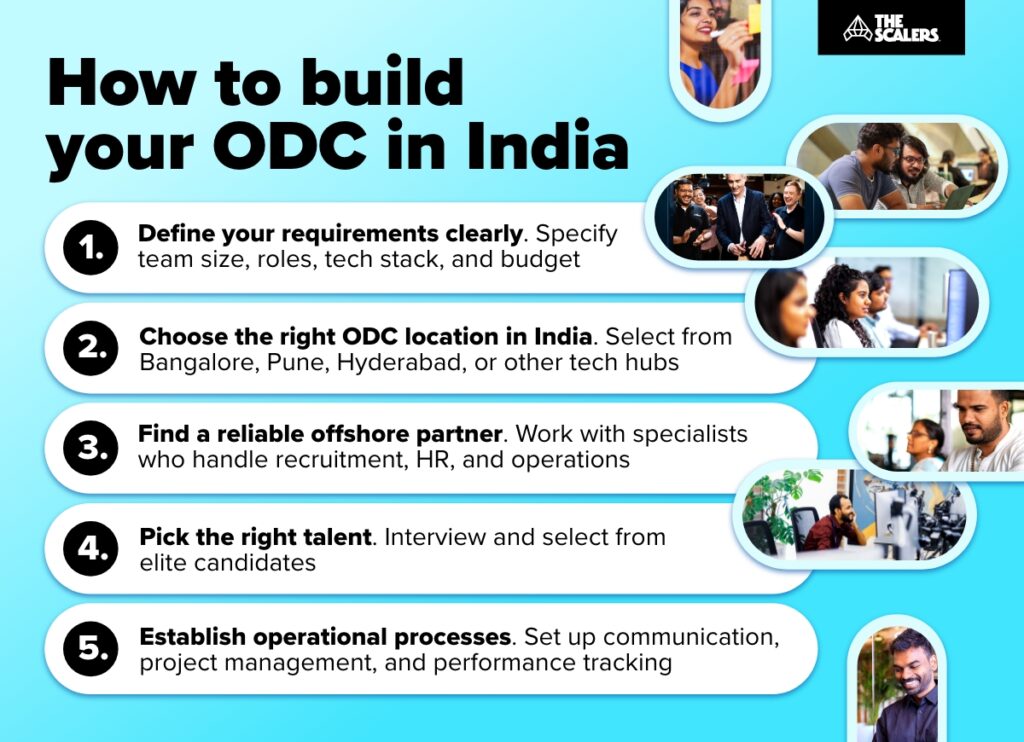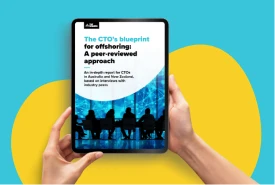- With an offshore development centre (ODC) you get dedicated teams that work exclusively for your company, unlike outsourcing, where resources are shared across clients.
- India offers access to world-class talent with strong technical skills, English proficiency, and experience in in-demand and niche technologies.
- Building an offshore development centre involves five key steps: defining requirements, choosing a location, finding a reliable partner, recruiting talent, and establishing operational processes.
- The right offshore development partner handles legal setup, HR, compliance, and operations so you can focus entirely on building your product.
Setting up an offshore development centre in India gives you direct access to some of the world’s best tech talent without the constraints of other hiring models.
At The Scalers, we’ve spent over a decade helping companies establish ODCs in India. We’ve seen what works, what doesn’t, and what separates successful setups from those that struggle. This guide walks you through everything we’ve learned from building 130+ offshore teams.
Why India is the best place to set up an offshore development centre
India has built a mature tech ecosystem over three decades, with established education systems, robust infrastructure, and a culture of continuous learning in fields like AI, cloud computing, and data science.
When you offshore to India you’re tapping into this depth. Bangalore stands out as the country’s premier tech hub:
- Over one million people in Bangalore today are software developers.
- Over 10 million people in India work in IT, and 40% are based in Bangalore.
- The city is known as ‘The Silicon Valley of Asia’ because the startup scene is thriving.
- It’s also home to many multinational firms, such as Google, Amazon, and Microsoft, which are rapidly expanding R&D centres there.

While Bangalore dominates headlines, India’s tech talent isn’t concentrated in just one city. According to the India Skills Report 2025, one of the most credible studies on talent demand and supply across India, several states stand out:
- Maharashtra leads the nation with an impressive 84% employability rate. The state excels in English proficiency (67.45%) and continues to attract skilled professionals across the technology and finance sectors.
- Delhi showcases a formidable employability rate of 78%, reinforcing its position as India’s second-most productive city with a GDP fluctuating between $210 billion and $369 billion. The capital maintains significant investments in skill development initiatives.
- Andhra Pradesh demonstrates high employability at 72%, highlighting its robust academic frameworks. The state ranks in one of the top positions for numerical abilities (71.98%) and maintains strong demand among job seekers, with 94.34% of surveyed engineers interested in taking internships.
- Uttar Pradesh maintains a strong talent pool with 70% employability and leads the nation in critical thinking (45%), computer skills (45.93%), and numerical abilities (80.12%). The state contributes over 8% to India’s GDP and continues to expand its IT infrastructure.
ODC vs. outsourcing: What’s the difference?
Many companies confuse outsourcing with setting up an offshore development centre, but they’re different approaches to building a tech team:
- Outsourcing means hiring engineers through a third party to complete specific projects or tasks. You define the scope, they deliver the work, and the relationship ends when the project is complete. The team working on your project likely handles multiple clients simultaneously.
- An offshore development centre is an extension of your company. The team works exclusively for you, operates as part of your organisation, follows your processes, and focuses entirely on your business objectives.

Offshore development centre in India: Benefits and challenges explained
Understanding the advantages and potential obstacles can help you determine if an ODC aligns with your business needs.
Benefits that drive business growth
Access to specialised skills
The Indian tech talent pool includes specialists in in-demand technologies and niche areas that might take months to find locally. In India’s tech hubs, you can build an ODC with senior Python, .NET, or C++ developers, as well as experts in legacy systems like COBOL, AI engineers or blockchain developers.
Cost-effectiveness
Building a team with top talent in the US, Europe, and Australia is becoming inaccessible for small and mid-sized companies. Especially after recent legislative changes, like the H-1B visa fee surge. If you set up an offshore development centre in India, you’ll be able to access the same or even higher quality engineers for a fraction of the price you’d pay at home.
Faster time to market
With a dedicated ODC team in India, you can accelerate software development cycles. Time zone differences work in your favour because your Indian team can continue working while you sleep.
Scalability on demand
With an established ODC in India, you can adjust your team size as business needs change. This agility becomes crucial when market conditions shift or new opportunities emerge.
Knowledge retention and continuity
Your ODC team accumulates deep knowledge about your systems, business logic, and technical debt. When someone leaves, their knowledge doesn’t walk out the door but stays within your dedicated team.
Challenges you’ll need to address
Cultural differences
Cultural gaps can exist when hiring offshore developers. Communication styles, feedback approaches, and work expectations may differ from what you’re used to. The solution isn’t to ignore these differences but to build bridges through clear communication protocols and cultural training on both sides. A reliable offshore development partner can help you solve these challenges.
Initial setup complexity
Establishing an ODC requires navigating Indian business regulations, setting up legal entities or partnerships, and understanding local employment laws. This requires on-the-ground expertise, which is why most companies work with experienced partners rather than going it alone.
Quality concerns
Misconceptions about the quality of Indian talent stem from the early days of low-cost outsourcing. When you work with a reliable ODC partner that implements proper recruitment processes and quality assurance protocols, your team’s output matches or exceeds local hires.
Security risks
Protecting intellectual property and ensuring data security requires deliberate planning. You need clear legal agreements, technical safeguards, and ongoing compliance monitoring. These challenges are manageable with the right approach and partner.
Which businesses benefit most from building an ODC in India?
Not every company needs an ODC. This offshore development model works best when specific conditions align with your business needs, for example:
- You’re a company scaling product development. Building software products requires continuous development, regular feature releases, and ongoing maintenance. An ODC in India provides the engineering capacity you need without local hiring constraints.
- You need a cross-functional team under one roof. ODCs aren’t just about developers. You can build complete product teams with engineers, data scientists, business analysts, QA specialists, DevOps engineers, and technical support, all working together in a dedicated facility.
- You want to establish an R&D centre for innovation. Many organisations build ODCs in India not just for production coding but for genuine research and development. An ODC setup allows you to develop new concepts and bring fresh ideas to life.
- You want complete operational control and scalability. Unlike outsourcing, where you’re limited by vendor capacity, an ODC gives you the infrastructure to scale from 5 to 100+ engineers on your own terms. You control hiring decisions, set processes, define culture, and scale on demand, all while your offshore partner handles the operational complexity.
If your business matches one or more of these scenarios, an offshore development centre in India is likely the right model for you.
Step-by-step guide: How to build an ODC team in India
Now that we’ve covered the why and the what, here’s the how. Follow these five steps to set up your offshore development centre in India, from defining requirements to building a fully operational team.

Step 1: Define your requirements clearly
The first step to building an offshore development centre is knowing exactly what you’re looking for, including the type of talent you want to hire and the team size.
Before making a decision, ask yourself:
- Do I want to scale this team in the future?
- What roles do I need filled (i.e., senior developers, architects, QA engineers, DevOps specialists, data scientists)?
- What tech stacks and frameworks must my team master?
- What’s my budget range?
- What level of integration with my existing team do I require?
This exercise helps you assess whether to build an initial small ODC team in India or establish your presence in the country with a group of hundreds of engineers and other professionals.
The more precise you are at this stage, the better your partner can help you build the right team. Vague requirements lead to hiring mismatches that cost time and money to correct.
Step 2: Choose the right ODC location in India
Once you’re clear about your needs, it’s time to find the ideal destination for your team.
One of the benefits of setting up an ODC in India is that there are multiple states and cities where you can find the talent you’re looking for. The country produces millions of engineers yearly who work and live across the nation in metropolitan areas like Mumbai, Bangalore, Pune, Hyderabad, and Chennai.
There’s top talent almost everywhere:
- Bangalore is the top choice for most offshore development centres. The city has the largest startup ecosystem in India, is home to R&D centres from big tech companies, and has the highest concentration of specialised talent in AI, ML, and cloud architecture.
- Pune is a strong alternative to Bangalore with a growing reputation. It has a significant presence of automotive and manufacturing tech companies and is known for its excellent engineering colleges that produce fresh talent yearly.
- Hyderabad is emerging as a major tech hub thanks to its competitive costs and talent density. There’s a growing startup scene, good infrastructure, and a lower cost of living compared to other Indian tech hubs.
- Chennai is a traditional IT services hub evolving toward product development. The city has established IT infrastructure with a conservative business culture.
- Mumbai is India’s financial capital. It’s an excellent location for financial services ODCs with a vast talent pool in data science and analytics.
For most companies setting up their first offshore development centre in India, Bangalore offers a unique balance of talent availability, ecosystem maturity, and global business practices.
Step 3: Find a reliable offshore partner
You know what you need and have already decided where to build your offshore development centre in India. Now, you must find an offshore partner that helps you find, hire, onboard, and set up your team in the country.
Most companies choose the partner route because it dramatically reduces time to productivity and minimises costly mistakes. This is what to look for in an ODC partner:
Evaluate the talent pool they draw from
If you want to have the best Indian Quant developers or Ruby on Rails experts in your team, look for partners known for hiring professionals with these skills. Ensure they demonstrate experience in your specific technical domain.
Examine their scalability and flexibility
Consider how your business requirements today differ from those you’ll have in a few years. If you plan to expand and onboard engineers in the future, choose a partner that allows you to scale your team on demand.
Assess cultural fit and communication
The engineers your partner sources for you must be culturally aligned with your business mission and vision. Beyond technical skills, cultural compatibility determines long-term success.
Prioritise security and quality assurance
Pick a partner that implements rigorous security measures. Companies with certifications like ISO/IEC 27001 comply with international information security management systems standards, meaning your data is protected.
When discussing quality assurance, verify that your partner implements processes to deliver detailed and regular performance reports. Your dedicated ODC in India should be formed by engineers with technical expertise to solve issues effectively.
Ongoing support, not just recruitment
Setting up the team is just the beginning. Your partner should provide HR support, performance management assistance, retention programs, and ongoing operational help.
Step 4: Pick the right talent
Your offshore partner will assist you with recruitment, but you have the final say in who will be part of your team. Here are the steps you’ll need to follow to hire the specialist you need:
Sourcing the best of the bunch
Start by building your tech team from elite candidates. This begins with the first search, pre-screening, and initial contact. An expert team builder on the ground in your chosen location will facilitate all of your sourcing based on scoped-out needs regarding programming languages and tech stacks.
Testing and assessing logic skills
Make sure to give candidates a variety of tests to see if they can tackle complicated problems. It is not always about knowing an answer but observing how they employ logic and analytical skills to work it out. Your offshoring partner will usually administer these tests on your behalf, based on your specific requirements.
Evaluating technical expertise
Candidates must also participate in a one-day, in-office assessment to measure their understanding of technical issues. They should be evaluated by a technical panel of experts from diverse backgrounds and expertise. Again, this should be arranged by your partner in the chosen offshore location.
Completing a mock assignment
Those who make it to the shortlist of candidates should take part in at least a three-day home project to assess their ability to architect a solution. This will show how well they would likely perform in their everyday activities.
Interviewing with HR
Hold an in-depth screening to understand your candidate’s personality better. You can find out what drives them, discover their strengths and weaknesses, and determine if they are a good fit. The engineers you hire aren’t external support but full-time employees. It’s important to ensure they’re an ideal match for a long-term ODC team rather than just a one-off project.
Interviewing with a manager
Have a conversation to find out whether the developer has the cultural compatibility needed for integrating into your business.
Conducting a final interview for your ODC team
The final interview is where you pick your chosen candidate from the list of final elite engineers that have been sourced and filtered by your chosen offshore partner.
Step 5: Establish operational processes
Running an effective offshore development centre requires clear processes from day one. Here’s what to set up:
Communication framework
- Daily standups timed to overlap working hours between locations.
- Weekly team meetings for broader alignment.
- Asynchronous communication standards for non-urgent matters.
- Clear escalation paths for blockers and urgent issues.
Project management
- Use PM tools like Jira, Linear, or Azure DevOps.
- Ensure your ODC team follows the same processes as your local team.
- Maintain consistency in sprint planning, retrospectives, and delivery cadence.
Performance tracking
- Track code quality through peer review scores and bug rates.
- Monitor velocity and predictability in sprint deliveries.
- Evaluate initiative and problem-solving capabilities.
- Assess communication and collaboration effectiveness.
- Measure impact on business objectives and outcomes.
Knowledge management
- Maintain comprehensive technical documentation.
- Document architectural decisions and rationale.
- Create and update process guides regularly.
- Ensure knowledge stays within the team, not just with individuals.
With these processes in place, your ODC functions as a true extension of your company, not a separate entity.
The Scalers: Your trusted partner for ODC setup in India
As you’ve seen throughout this guide, choosing an experienced offshore development partner is critical. With the right partner, you can hire elite talent and set up operations in India without the typical headaches of going it alone.
At The Scalers, we’ve helped companies of all sizes and industries establish and scale ODCs in India over the past decade, leveraging the country’s vast talent pool.

Good proof of it is the ODC we established in Bangalore for Johnson Health Tech, a global leader in commercial and residential fitness equipment manufacturing. We initially built an 8-engineer ODC that doubled their Web Team delivery capacity and enabled 24/7 development capabilities.
The Scalers are different from other partners I’ve worked with in the past as I don’t have to worry about any of the legal issues; any of the HR issues; any of the IT issues; or any of the building requirements. All I have to do is get up and go at the scale and the speed that I need to.
Our offshore model makes ODC setup straightforward. We build teams with elite talent and handle everything on the ground, from legal setup and HR to office space and IT infrastructure, so our partners can focus entirely on their product.
Conclusion
You now have the roadmap: why India leads as an ODC destination, which businesses benefit most, and the five steps to go from planning to launch. Success comes down to treating your ODC as a genuine extension of your business, not a cost-cutting exercise.
| Ready to explore setting up an offshore development centre in India? If so, send us a message to discuss your specific needs, answer your questions honestly (including whether an ODC makes sense for your situation), and outline what a partnership would look like. |
FAQs
An offshore development centre is a dedicated facility in another country where a team of professionals works exclusively for your company. These teams typically include software developers, QA engineers, data scientists, business analysts, data analysts, project managers, DevOps specialists, and other technical and business professionals who function as an extension of your business.
From initial planning to having your first team members productive, expect 2-3 months. This includes defining requirements, recruitment and screening, and onboarding. With an experienced partner like The Scalers, you can compress this timeline while maintaining quality.
Costs vary based on team size, seniority levels, and location within India. Junior developers start at around $15,000-25,000 annually, while senior developers range from $40,000-65,000 annually. These figures include salary, benefits, and infrastructure costs. Working with an offshore partner adds a service fee but eliminates the need to establish legal entities, manage HR, or handle local compliance, saving you significant time and reducing risk.
Quality control starts with rigorous hiring and continues through clear processes like code reviews, automated testing, CI/CD pipelines, and regular performance tracking. When you work with a partner that prioritises quality assurance and provides detailed performance reports, your ODC team will match or exceed the quality of local hires.
Yes, that’s one of the key advantages of setting up an offshore development centre in India. With an established ODC and the right partner, you can hire more specialists as your business grows.
Attrition happens everywhere, including ODCs. A reliable offshore partner will provide knowledge transfer support during the notice period, begin recruitment for a replacement immediately, and focus on retention programs to minimise turnover.
Build Your Team,
Not Just a Contract
With The Scalers’ offshore dedicated development team, you get engineers who join your workflow for the long run. Grow steadily, stay flexible, and work with people who care about the product as much as you do.








